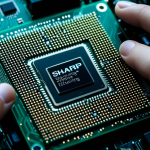Overview of Emerging Technologies Shaping Computing Hardware
Emerging technologies are fundamentally transforming computing hardware trends, driving an evolution beyond traditional designs. Among the most impactful are artificial intelligence (AI), quantum computing, advanced semiconductors, and edge computing. These domains collectively redefine performance benchmarks and capabilities.
AI integration demands specialized hardware that accelerates machine learning processes, influencing the architecture of processors to prioritize parallelism and energy efficiency. Quantum computing introduces quantum processors that promise exponential speedups for specific tasks but face significant challenges in error correction and stable qubit implementation. Advanced semiconductors, including innovations in materials like graphene and silicon carbide, enable unprecedented miniaturization and efficiency improvements, crucial for sustaining the pace predicted by Moore’s Law despite physical limits. Meanwhile, the rise of edge computing shifts computation closer to data sources, reducing latency and bandwidth needs with decentralized hardware tailored for IoT hardware.
Also to read : How is UK computing hardware contributing to advancements in machine learning?
Innovation in hardware design is essential to meet growing demands around speed, power efficiency, and flexibility. The current landscape emphasizes a blend of these emerging technologies, which create new pathways for performance and reshape expectations in computing hardware’s future.
Artificial Intelligence and Machine Learning Integration
AI hardware is a cornerstone of current computing hardware trends, driving a shift toward specialized components designed for machine learning acceleration. Graphics Processing Units (GPUs), Tensor Processing Units (TPUs), and dedicated Neural Processing Units (NPUs) form the backbone of this transformation. These devices enhance processing speed significantly by handling parallel computations efficiently, which conventional CPUs struggle with.
This might interest you : What impact does UK computing hardware have on gaming performance?
How do these specialized processors improve energy efficiency? By focusing on AI-specific tasks such as matrix multiplications and neural network operations, they reduce redundant power consumption inherent in general-purpose chips. This design approach refines the architecture of computing hardware, enabling both faster and more energy-conscious AI workloads.
Industry adoption is widespread across sectors ranging from automotive to healthcare. For example, autonomous vehicles rely on edge devices equipped with AI hardware for real-time decision-making. This integration exemplifies how emerging technologies redefine hardware performance requirements, pushing innovation to accommodate complex algorithms and data-intensive applications.
The evolution of AI hardware reinforces the broader current technology overview, cementing the importance of customized, efficient processing units in shaping the future landscape of computing hardware.
Advances in Quantum Computing Hardware
Quantum computing hardware centers on quantum processors, which use qubits to perform computations beyond classical limits. Unlike traditional bits, qubits exploit superposition and entanglement, enabling exponential speedups in tasks like cryptography and optimization. Development of stable quantum processors remains challenging due to qubit coherence issues and error correction demands.
What progress has been made in hardware implementation? Research has produced multiple qubit technologies, such as superconducting circuits and trapped ions, each offering trade-offs in scalability and fidelity. While quantum error correction protocols are advancing, fully fault-tolerant quantum processors are still in early stages.
The future of hardware in quantum computing looks promising as industry investments increase, accelerating prototype improvements. Companies and research institutions are exploring hybrid quantum-classical architectures to integrate early quantum processors with existing systems effectively. These developments may soon impact specific industries by solving problems infeasible for classical hardware.
Thus, quantum computing hardware, despite current hurdles, represents a pivotal component in emerging technologies and computing hardware trends, promising to revolutionize computational capacity as research and development continue.
Evolution of Semiconductor Technologies
Emerging technologies in advanced semiconductors are key drivers behind contemporary computing hardware trends. The progress in chip manufacturing pushes the boundaries of miniaturization, exemplified by the development of 3nm chips which pack more transistors into smaller spaces. This advancement enhances processing speed and energy efficiency simultaneously, crucial as Moore’s Law reaches physical limits.
New materials such as graphene and silicon carbide are reshaping hardware capabilities. Graphene’s exceptional electrical conductivity and silicon carbide’s superior thermal resilience enable chips to operate faster and cooler. These innovations address critical challenges in power consumption and heat dissipation faced by traditional silicon-based semiconductors.
How do these material advances impact hardware design? They facilitate the creation of chips with higher performance levels without proportional increases in energy use or size. This balance is central to the current technology overview, which emphasizes energy efficiency and compact form factors alongside computational power.
Thus, semiconductor evolution is foundational for sustainable growth in computing hardware, influencing everything from consumer electronics to large-scale data center efficiency.
Edge Computing and Decentralized Hardware Architectures
Edge computing is reshaping computing hardware trends by decentralizing data processing closer to where it’s generated. This shift reduces latency and bandwidth usage by minimizing reliance on centralized cloud servers. As a result, IoT hardware—devices embedded with sensors and connectivity—gains importance for real-time analytics and decision-making in applications like smart cities and autonomous systems.
How does edge computing achieve these benefits? By distributing workloads to localized hardware, it ensures faster response times and decreases network congestion. The hardware designs supporting this approach focus on compactness, energy efficiency, and resilience to varied environmental conditions.
Decentralized computing models also enable scalability, allowing networks to expand without overloading central resources. Emerging hardware architectures integrate these principles, featuring modular components that can be upgraded or replaced to match changing demands.
In sum, edge computing’s hardware innovations are critical to the current technology overview, highlighting the move toward distributed systems. This evolution supports a broad range of sectors by enhancing performance and flexibility while addressing the limitations of traditional centralized infrastructures.
Scalability, Flexibility, and Modular Hardware Trends
Emerging technologies in computing hardware trends increasingly emphasize hardware scalability and modular design to meet evolving performance demands. Modular hardware allows components to be upgraded or replaced independently, offering flexibility in adapting to technological advances without full system replacement. This approach addresses both cost and sustainability concerns.
How does modular design improve flexibility? By enabling interchangeable parts, systems can scale capacity or functionality efficiently. For example, in data centres, modular servers permit incremental expansion as workloads grow, optimizing resource allocation. Similarly, consumer devices benefit from modular components that extend device lifespan and customization.
Flexible computing architecture also supports diverse deployment environments. It ensures compatibility across varying hardware profiles, accommodating different processing needs or energy constraints. These trends reflect the broader current technology overview where adaptability is vital for future-proof hardware solutions.
Hardware scalability combined with modular design transforms enterprise IT and consumer markets by offering tailored solutions that evolve alongside emerging technologies. This evolution in computing hardware trends drives a new era of responsive, cost-effective, and sustainable hardware innovation.
Industry Predictions and Future Trends in Computing Hardware
Experts predict that future computing trends will be shaped by continuous innovation in emerging technologies like AI, quantum computing, and advanced semiconductors. What breakthroughs are anticipated? Leading analysts foresee enhanced quantum processors becoming more stable and scalable, enabling broader practical applications. In AI hardware, expect increased integration of neural processing units with enhanced energy efficiency and speed.
How will the technology roadmap evolve? It emphasizes hybrid architectures combining conventional and quantum components, modular hardware for adaptability, and edge computing expansion to support real-time processing demands. Scalability and flexibility remain central, with hardware designed for seamless upgrades to keep pace with rapid software and algorithmic advancements.
Challenges include overcoming materials limitations in chip manufacturing and managing heat dissipation in ever-denser components. Yet, opportunities abound as these trends promise greater computational power and efficiency across industries. Enterprises adopting these innovations early can gain competitive advantages through improved data processing and responsiveness.
In sum, understanding this current technology overview equips stakeholders to navigate an evolving landscape where hardware innovation will define competitive computing capabilities.






